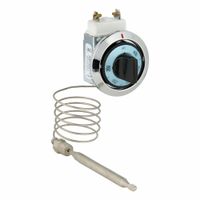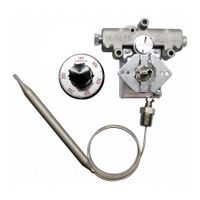Call +(254) 703 030 000 / 751 483 999 / 721 704 777
- Home
- Furnishings Appliances Hospitality
- Appliances
- Ovens Warming Equipment
- Cooking Appliance Controls
.....Read More
Frequently Asked Questions
What are the different types of cooking appliance controls?
Cooking appliance controls can be broadly categorized into the following types:
1. **Manual Controls**: These include knobs, dials, and buttons that require physical manipulation. They are straightforward, offering tactile feedback and are often found on traditional stoves and ovens.
2. **Digital Controls**: These use electronic interfaces such as touchpads or digital displays. They allow for precise temperature settings and often include timers and pre-set cooking programs.
3. **Smart Controls**: Integrated with Wi-Fi or Bluetooth, these controls allow remote operation via smartphones or tablets. They often feature apps for recipe guidance, monitoring, and adjusting settings from a distance.
4. **Touch Controls**: Similar to digital controls but more advanced, these use capacitive touch technology. They offer a sleek design and are often found on modern induction cooktops and ovens.
5. **Voice Controls**: Enabled by smart home assistants like Amazon Alexa or Google Assistant, these allow users to control appliances using voice commands, offering hands-free operation.
6. **Sensor Controls**: These use sensors to automatically adjust cooking settings. For example, some ovens have sensors that detect food moisture levels to adjust cooking time and temperature.
7. **Rotary Controls**: A type of manual control, these are often used for setting temperatures or power levels on appliances like microwaves and toasters.
8. **Slide Controls**: Found on some induction cooktops, these allow users to slide their finger along a scale to adjust heat levels.
9. **Push-to-Turn Controls**: A safety feature on some gas stoves, these require the user to push the knob in before turning, preventing accidental activation.
10. **Programmable Controls**: Allow users to set specific cooking sequences or schedules, often found in advanced ovens and slow cookers.
Each type of control offers different levels of precision, convenience, and safety, catering to various user preferences and cooking styles.
How do gas-cooking appliance controls work?
Gas-cooking appliance controls work by regulating the flow of gas to the burners, ensuring safe and efficient operation. The primary components involved are the control knobs, gas valves, ignition system, and safety features.
Control knobs are the user interface, allowing the user to adjust the flame size. When a knob is turned, it operates a gas valve, which controls the amount of gas flowing to the burner. These valves are typically of two types: manual and thermostatic. Manual valves allow for direct control over the gas flow, while thermostatic valves adjust the flow based on temperature settings.
The ignition system is crucial for lighting the gas. Modern gas appliances often use electronic ignition systems, which create a spark to ignite the gas when the control knob is turned to the "light" position. Older models may use a pilot light, a small flame that burns continuously to ignite the gas when needed.
Safety features are integral to gas-cooking appliances. One common feature is the flame failure device (FFD), which detects if the flame is extinguished and automatically shuts off the gas supply to prevent leaks. Another is the thermocouple, a sensor that detects heat from the flame and signals the gas valve to remain open. If the flame goes out, the thermocouple cools, causing the valve to close and stop the gas flow.
Overall, gas-cooking appliance controls are designed to provide precise control over cooking temperatures while ensuring user safety through various built-in mechanisms.
How do electric-cooking appliance controls differ from gas controls?
Electric-cooking appliance controls differ from gas controls primarily in their mechanism of operation and precision.
Electric appliances typically use digital or analog controls to regulate the flow of electricity to heating elements. These controls can be in the form of dials, touchpads, or digital interfaces. They allow for precise temperature settings and often include features like timers, pre-set cooking modes, and safety locks. The heat is adjusted by varying the electrical current, which changes the resistance in the heating element, thus altering the temperature. Electric controls can offer consistent and even heating, making them ideal for tasks requiring precise temperature management.
In contrast, gas appliance controls are generally more manual and involve mechanical knobs that regulate the flow of gas to the burners. Turning the knob adjusts the size of the flame, which directly influences the heat output. Gas controls provide immediate visual feedback through the flame size and offer rapid temperature changes, which is advantageous for techniques like searing or stir-frying. However, they may lack the precision of electric controls, as the temperature is adjusted by eye rather than by exact settings.
Safety mechanisms also differ; electric appliances often have automatic shut-off features, while gas appliances may include flame failure devices to cut off gas supply if the flame is extinguished. Overall, electric controls offer more precision and additional features, while gas controls provide immediate heat adjustments and are often preferred for their responsiveness.
What are the benefits of using smart cooking appliance controls?
Smart cooking appliance controls offer numerous benefits, enhancing convenience, efficiency, and safety in the kitchen. Firstly, they provide remote access and control, allowing users to operate appliances via smartphones or voice commands, which is particularly useful for multitasking or managing cooking while away from the kitchen. This feature also enables preheating ovens or starting slow cookers remotely, saving time and ensuring meals are ready when needed.
Secondly, smart controls enhance energy efficiency by optimizing appliance performance. They can adjust cooking times and temperatures based on the type of food, reducing energy consumption and lowering utility bills. Additionally, these controls often include energy monitoring features, providing insights into usage patterns and helping users make informed decisions to further conserve energy.
Safety is another significant benefit. Smart appliances can send alerts and notifications if something goes wrong, such as a forgotten oven left on or a stovetop burner overheating. This reduces the risk of accidents and potential fire hazards. Some appliances also have automatic shut-off features, adding an extra layer of safety.
Moreover, smart cooking controls often come with integrated cooking guides and recipe suggestions, making it easier for users to try new dishes and improve their culinary skills. These guides can adjust cooking settings automatically, ensuring optimal results without the need for constant monitoring.
Finally, smart appliances can be integrated into a broader smart home ecosystem, allowing for seamless interaction with other devices, such as smart speakers or lighting systems, creating a more cohesive and efficient home environment. Overall, smart cooking appliance controls offer a blend of convenience, efficiency, safety, and enhanced cooking experiences, making them a valuable addition to modern kitchens.
How can I troubleshoot issues with my cooking appliance controls?
1. **Check Power Supply**: Ensure the appliance is plugged in and the outlet is functioning. Test with another device to confirm power supply.
2. **Inspect Circuit Breaker**: Verify that the circuit breaker hasn’t tripped. Reset if necessary.
3. **Examine Control Panel**: Look for visible damage or dirt. Clean with a soft cloth and mild cleaner if needed.
4. **Consult the Manual**: Refer to the user manual for troubleshooting tips specific to your model.
5. **Reset the Appliance**: Unplug the appliance for a few minutes, then plug it back in to reset the controls.
6. **Test Buttons and Knobs**: Ensure all buttons and knobs are responsive. If sticky or unresponsive, clean or replace them.
7. **Check for Error Codes**: If the appliance displays error codes, refer to the manual for their meanings and solutions.
8. **Inspect Wiring**: Look for loose or damaged wires. If found, consult a professional for repair.
9. **Update Software/Firmware**: If applicable, check for software updates that might resolve control issues.
10. **Temperature Calibration**: If temperature settings are off, recalibrate according to the manual’s instructions.
11. **Seek Professional Help**: If issues persist, contact customer support or a professional technician.
12. **Warranty and Service**: Check if the appliance is under warranty for free repair or replacement.
13. **Avoid DIY Repairs**: For complex issues, avoid DIY repairs to prevent voiding the warranty or causing further damage.
Are there universal controls for all cooking appliances?
No, there are no universal controls for all cooking appliances. Cooking appliances vary widely in design, function, and technology, which necessitates different control mechanisms. Each type of appliance, such as ovens, stoves, microwaves, and slow cookers, has specific controls tailored to its unique functions. For instance, an oven may have controls for temperature settings, cooking modes, and timers, while a microwave might have controls for power levels, cooking time, and preset functions.
The diversity in cooking appliances is further compounded by differences in brands and models, each offering unique features and user interfaces. Some appliances may have digital touchscreens, while others use analog dials or buttons. Additionally, smart appliances may integrate with home automation systems, offering app-based controls or voice commands, which are not applicable to traditional appliances.
Safety standards and regulations also influence control designs, as manufacturers must ensure that their products are safe and easy to use. This results in variations in control layouts and functionalities to meet different safety requirements and user preferences.
While there are no universal controls, there are some commonalities, such as the presence of on/off switches, temperature settings, and timers. However, the specific implementation of these controls can vary significantly. Therefore, users must familiarize themselves with the controls of each specific appliance they use.
How do I install or replace cooking appliance controls?
1. **Safety First**: Turn off the power supply to the appliance at the circuit breaker to prevent electrical shock.
2. **Access the Controls**: Remove any panels or covers on the appliance to access the control panel. This may require unscrewing or unclipping parts.
3. **Identify the Controls**: Locate the specific control you need to replace, such as knobs, switches, or electronic control boards.
4. **Remove the Old Control**: Carefully disconnect any wires or connectors attached to the old control. Take note of the wiring configuration or take a photo for reference.
5. **Install the New Control**: Connect the new control by attaching the wires or connectors in the same configuration as the old one. Ensure all connections are secure.
6. **Reassemble the Appliance**: Replace any panels or covers that were removed. Ensure all screws or clips are properly secured.
7. **Test the Appliance**: Restore power at the circuit breaker and test the appliance to ensure the new control functions correctly.
8. **Final Checks**: Verify that all controls are working as expected and that there are no unusual noises or issues.
9. **Safety Precautions**: If unsure about any step, consult the appliance’s manual or contact a professional technician.

